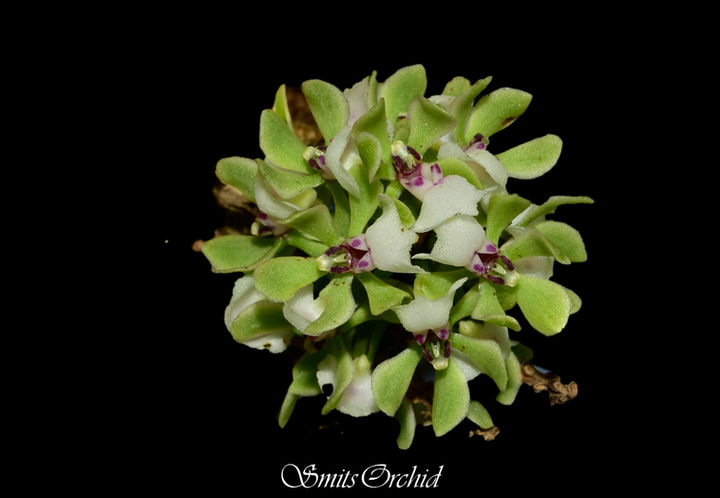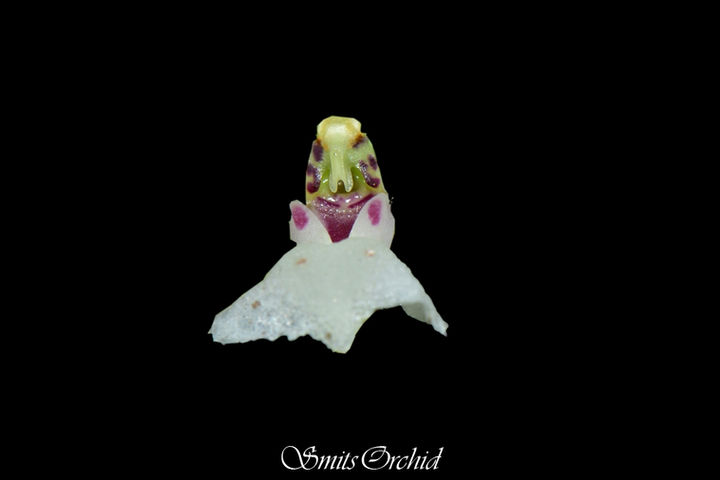
Smithsonia C.J.Saldanha
Sub family: Epidendroideae
Tribe Vandeae
SubTribe: Aeridinae
Derivation of name The generic name commemorates James Smithson (1754–1829), founder of the Smithsonian Institution (Washington, D.C., USA).
Salient features
-
Epiphytic herbs.
-
Roots many, arising from base of stem, up to 100 or more cm long, 0.4–0.5 cm in diameter, sometimes flattened and closely adhering to trunk or branch.
-
Stem with distichous leaves.
-
Leaves 2–6, 2.5–10.0 × 0.5–2.4 cm, oblong to linear-oblong or elliptic-lanceolate, sometimes slightly falcate, articulate, sheathing at base, green or rarely mottled with purple or dark green, unequally or obtusely bilobed at apex with (S. straminea) or without a sharp median mucro in between.
-
Inflorescence spreading or pendent, elongate or (sub)umbellate raceme with up to 20 flowers, 5–15 cm long, axillary;
-
bracts 2 mm long, broadly oblong-ovate or ovate triangular, acute or obtuse.
-
Flowers c. 0.6–1.2 cm wide, resupinate greenish to yellow, either with a solitary reddish brown spot (S. mac ulata (Dalzell) C.J.Saldanha), one or two violet spots (S. straminea) or without spots on sepals and petals, labellum white, often marked with pink or violet.
-
Sepals Dorsal sepal obovate, obovate-oblong, or oblanceolate, often narrowed at base and gland-dotted, 3–5-veined, obtuse or acute at apex.
-
Lateral sepals obovate or broadly obovate to obovate-oblong, narrowed at base (S. maculata) or not, 3–5-veined, gland-dotted (S. viridiflora (Dalzell) C.J.Saldanha) or not, obtuse at apex.
-
Petals obovate, oblong or obovate-oblong, 3–5-veined, obtuse at apex.
-
Labellum white, trilobed, shortly or deeply saccate at base, and immovably attached to column base, side lobes tri angular, erect, sometimes connate below, narrow and recurved, midlobe entire or weakly trilobed; spur subconical, straight, 3–4 mm long, naked within or with a tuft of white hairs (S. maculata).
-
Column 1–2 mm long, semi-terete, without a foot; anther conical, pollinia two, deeply and unequally cleft, stipe narrow, viscidium oblong, bifid; rostellum bilobed. Ovary with pedicel 3–7 mm long.
-
Capsule 3–5 cm long, oblong or fusiform.

Smithsonia viridiflora (Dalzell) C.J.Saldanha
In J. Bombay Nat. Hist. Soc. 71: 75 (1974)
-
Aerides dalzelliana (Santapau) Garay in Bot. Mus. Leafl. 23: 158 (1972)
-
Gastrochilus dalzellianus (Santapau) Santapau & Kopadia in J. Bombay Nat. Hist. Soc. 59: 842 (1963)
-
Gastrochilus viridiflorus (Dalzell) Kuntze in Revis. Gen. Pl. 2: 661 (1891)
-
Micropera viridiflora Dalzell in Hooker's J. Bot. Kew Gard. Misc. 3: 282 (1851)
-
Saccolabium viridiflorum (Dalzell) Lindl. in J. Proc. Linn. Soc., Bot. 3: 36 (1858)
-
Sarcochilus dalzellianus Santapau in Kew Bull. 3: 498 (1948 publ. 1949)
-
Sarcochilus viridiflorus (Dalzell) T.Cooke in Fl. Bombay 2: 697 (1907), nom. illeg.

Ecology Epiphytes found growing on Diosyros sp., Memeceyon unbellatum plants
Stem very short, sheathed.

Leaves usually 2 with a small one in between, 3-9x 1.5-2 cm, elliptic-lanceolate, tapering at base, entire, unequally bilobed at apex, lobes entire.

Inflorescence Racemes corymbose umbellate, at apex of peduncle; peduncles suberect, about 1-2 mm thick, 3-5 cm long, terete, bracteate.
Bracts 1.5-2x 1.2 mm, lower ones completely ensheathing the peduncle upper ones not so, broadly ovate oblong, entire, subobtuse to acute.

Flowers greenish-white, pedicellate, bracteate. Pedicel with ovary 7 mm long, brownish-green.

Sepals subequal, broadly obovate and tapering at base, entire, rounded or mucronulate, pale green; dorsal sepal 7X 3-3.5 mm, often with a few yellowish-red spots at base; lateral sepals 6x 3-3.5 mm.

Petals 6-7X 3.5 4 rom, pale green, obovate and tapering at base, entire, obtuse, slightly falcate, with somewhat incurved apices.

Labellum fleshy, white; lateral lobes erect, about 1 mm long, acute, their anterior margins red-streaked; midlobe (epichile) semicircular, 2.5-3 x.5-7 mm, apiculate; spur 3.5 rom long, fleshy, conical, rounded, white with a crimson patch at back inside corresponding to the red streaks of lateral lobes of lip.

Column about 2 mm long, stout, semiterete, footless; clinandrium green with dark reddish-brown patches on top and sides.
Anther pale yellow, 1.5X 1.25 mm, broadly obpyriform with a truncate apiculum ;
pollinia 2, deeply grooved, 0.5 mm in diameter. caudicle 1.5 mm long, narrow; gIand narrow, linear, erect, 0.5 mm long.

Capsules 3-5cm long, narrowly fusiform, ribbed, purplish-brown.
Flowering: May to June.
Fruiting: June to March





















